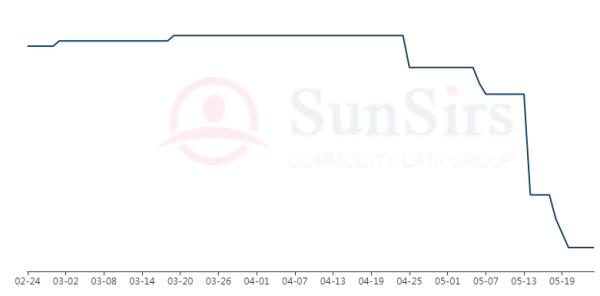국내 반도체 및 디스플레이 생산의 필수 소재인 삼불화질소(NF3)가 하반기 원료가격 하락 및 수요 증가에 수익성이 대폭 개선될 것으로 기대된다.

▲무수불산 최근 3개월 가격 동향(자료 : SunSirs)
반도체 출하량 증가 수요량 급증 전망
증산無·공장 풀가동, 물량 조절 불가피
국내 반도체 및 디스플레이 생산의 필수 소재인 삼불화질소(NF3)가 하반기 원료가격 하락 및 수요 증가에 수익성이 대폭 개선될 것으로 기대된다.
중국 원자재 가격 동향 데이터 전문 사이트인 SunSirs에 따르면 최근 NF3의 원료인 무수불산(Hydrofluoric acid) 가격이 4월말부터 지속적으로 하락하고 있는 것으로 나타났다.
무수불산의 가격은 지난 2021년 4월15일 기준으로 톤당 1만622RMB를 기록하며 지속 상승했는데, 4월24일을 고점으로 지속적으로 하락해 5월25일 기준으로 톤당 1만180RMB를 기록하고 있다.
국내 주요 NF3 생산 기업들은 1분기 매출 상승 및 판매량 증가에도 불구하고, 원재료價 등 매출원가 상승에 수익성은 오히려 예전에 비해 감소한 바 있다.
특히 국내 1분기 공장 가동률이 100%에 육박할 만큼 수요가 증가했기 때문에 수익성 개선 측면에서는 아쉬움을 남겼다.
이런 가운데 하반기에는 수익성이 대폭 개선되고 제품 가격도 상승할 것으로 전망이다.
우선 주요 수요처인 반도체 업계가 비메모리 공급부족에 2021년 2분기부터 비메모리 출하량이 증가할 것으로 예상된다.
또한 코로나19로 인한 경기 침체에서 벗어나 경기 회복세로 접어들며, B2B 수요가 높은 서버 시장이 반도체 시장을 주도할 것으로 예상되고 있다. 특히 업계에 따르면 서버 업체들의 반도체 재고량이 계속 줄어들고 있어 반도체 수요가 상당히 높은 것으로 알려지고 있다.
이에 2021년 2분기부터 DRAM 출하량이 생산량을 훌쩍 뛰어 넘으며, 재고량 추이가 정상 재고량보다 떨어질 것으로 전망되고 있으며, 하반기 메모리 가격 상승과 함께 출하량 증가를 위한 물량 조정도 있을 것으로 예상되고 있다.
또한 NAND와 파운드리 업체들의 공격적인 증설이 재개되고, 국내 OLED와 중국 LCD의 추가 증설도 전망되고 있다.
이에 NF3의 수요가 지속적으로 증가할 것으로 보인다.
이런 가운데 NF3 생산의 경우 1분기 상당히 타이트했고, 2분기에도 업체별로 물량 조절에 나설 정도로 타이트 한 것으로 알려지고 있다.
특히 올해는 NF3의 증설이 예정돼 있지 않기 때문에 올해 지속적인 공급부족에 시달릴 것으로 예상되고 있다.
업계 관계자는 “현재 생산이 타이트한 것은 사실이나 숏티지 가능성 또는 하반기 물량 조절에 대해 언급하기는 어렵다”며 “6월 수요처들의 하반기 주문 상황을 지켜봐야 하는 상황”이라고 전했다.
한편 NF₃는 반도체 생산의 주요 공정인 화학적기상증착법(CVD) 챔버 내에서 웨이퍼에 박막을 입힌 후 남아있는 이산화규소(SiO₂)나 질화규소(SiN₄)와 같은 불순물과 반응해 사플루오린화규소(SiF₄)로 내부를 세척하는데 사용된다.
